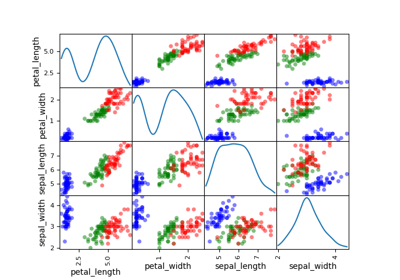andrews_curves module¶
Draw Andrews curves from a Dataset.
The AndrewsCurves class implements the Andrew plot, a.k.a. Andrews curves,
which is a way to visualize \(n\) samples of a high-dimensional vector
in a 2D referential by projecting each sample
onto the vector
which is composed of the \(d\) first elements of the Fourier series:
Each curve \(t\mapsto f_i(t)\) is plotted over the interval \([-\pi,\pi]\) and structure in the data may be visible in these \(n\) Andrews curves.
A variable name can be passed to the DatasetPlot.execute() method
by means of the classifier keyword
in order to color the curves according to the value of the variable name.
This is useful when the data is labeled.
- class gemseo.post.dataset.andrews_curves.AndrewsCurves(dataset, classifier)[source]
Bases:
DatasetPlotAndrews curves.
- Parameters:
- Raises:
ValueError – If the dataset is empty.


